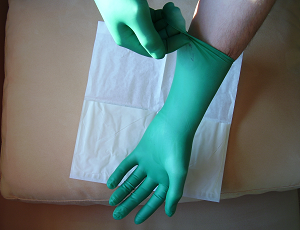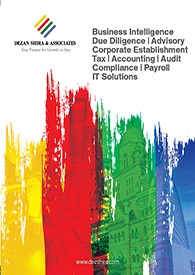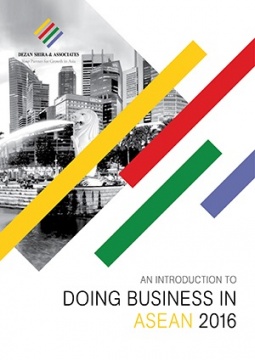Getting a Grip on Malaysia’s Rubber Glove Industry
By Alexander Chipman Koty
 About 133.6 billion pieces of rubber gloves – 63 percent of the world total – came from Malaysia in 2016, as the Southeast Asian nation has carved a niche in the industry. Exports were worth an estimated RM 14.3 billion, continuing the country’s streak as the world leader in rubber glove production for over two decades running. 2016’s revenues represent 14 percent growth over the RM 12.1 billion accumulated in 2015.
About 133.6 billion pieces of rubber gloves – 63 percent of the world total – came from Malaysia in 2016, as the Southeast Asian nation has carved a niche in the industry. Exports were worth an estimated RM 14.3 billion, continuing the country’s streak as the world leader in rubber glove production for over two decades running. 2016’s revenues represent 14 percent growth over the RM 12.1 billion accumulated in 2015.
The global rubber glove industry is expected to maintain strong annual growth of 8 to 10 percent over the coming years, including demand for an estimated 55 billion additional gloves over the next five years, primarily driven by increasing consumption in emerging markets. Malaysia could be the largest beneficiary of this increasing demand, as export revenue from rubber gloves is projected to reach RM 15.2 billion in 2017.
Malaysia’s dominance in the rubber glove industry is not simply due to its rich natural rubber resources, as similarly endowed neighbors Thailand and Indonesia have a far smaller market share of 21 and three percent, respectively. Rather, the rubber glove industry has been specifically targeted for development by the government, and it now comprises over 70 percent of Malaysia’s rubber product exports. Owing to strong government support to industrialize the country’s natural resources and develop unique competitive advantages, Malaysia has established a leading edge in the still-expanding rubber glove industry.
![]() RELATED: Pre-Investment and Market Entry Advisory from Dezan Shira & Associates
RELATED: Pre-Investment and Market Entry Advisory from Dezan Shira & Associates
Malaysia’s advantage
As with many other Southeast Asian nations, Malaysia is flush with natural resources. Revenues from the country’s petroleum reserves constitute over 40 percent of the government’s annual budget, and Malaysia provides about 40 percent of the world’s palm oil. Malaysia is the third largest producer of rubber, behind ASEAN peers Thailand and Indonesia.
Although natural resources make up a significant portion of Malaysia’s economy, the country is not reliant on simple extraction. Malaysia has developed a manufacturing sector that can leverage its resources to form a comparative advantage, giving rubber glove manufacturing a cohesive national ecosystem. Leading rubber glove manufacturers Top Glove, Hartalega Holdings, and Kossan all hail from Malaysia. In total, there are 106 rubber glove factories in Malaysia, 60 of which are located in the wealthy province Selangor, while Perak has 18, Negri Sembilan 10, Penang six, Malacca seven, Johor and Kedah two each, and Kelantan one.
The rubber industry is one of 12 National Key Economic Area sectors – promoted industries to help Malaysia reach high-income status. Entry Point Project 9.2 of the promotion aims to increase Malaysia’s market share in latex gloves to 65 percent by 2020 through 13 percent annual growth. To accomplish this, the government offers special support, such as reduced gas prices and tax breaks. The former is particularly significant, given that the cost of gas generally represents 10-12 percent of total costs for rubber glove manufacturers.
While natural resources and related industries are restricted from foreign investment in many countries, this is not the case in Malaysia’s rubber glove industry. Rubber glove manufacturing is designated as a promoted activity under the Promotion of Investment Act 1986, meaning foreign investors are allowed 100 percent equity and can acquire tax incentives such as Pioneer Status and Investment Tax Allowance.
Growth opportunities
The use of rubber gloves in the healthcare and foodservice industries gives the product a consistent market. Particularly in developed countries, the use of rubber gloves for certain activities is mandated by law. Although advanced economies such as the US, EU, and Japan consume about 68 percent of rubber gloves, growing government expenditure, healthcare needs, and awareness of health-related issues in markets such as emerging Asia, the Middle East, and Africa will drive the industry’s expansion going forward. Glove consumption per capita in Asia is a low 11 pieces per person per year, compared to the worldwide average of 50 pieces per person per year and about 100 pieces in developed markets like the US and EU.
This is particularly the case for China, which has a rapidly aging population that will demand significant healthcare in the near future. China imported 71 percent of its rubber medical gloves from Malaysia in 2015, spending US$96 million in the process. Overall, China’s healthcare spending is set to increase from US$640 billion in 2015 to US$1 trillion by 2020. China consumes only three pairs of gloves per person per year, while India – another huge potential growth market – consumes just two pairs per year, indicating enormous room for growth in these countries.
Latex powdered gloves are more frequently used in developing countries, while the more resilient nitrile is favored in advanced economies. As glove use becomes more widespread in developing countries, latex will be the initial beneficiary, though in the long term, nitrile will likely become more popular in these markets. Beyond these two main categories, some companies are experimenting with more customized and experimental products, such as multi-colored gloves and gloves with more than one texture, to innovate and create new markets.
![]() RELATED: An Introduction to e-Commerce in Malaysia
RELATED: An Introduction to e-Commerce in Malaysia
Challenges
As an industry highly reliant on natural resources – namely rubber and to a lesser extent oil and gas – the costs for producing rubber gloves and their ultimate selling price can be unpredictable. For example, in early 2016, natural rubber prices fell by nearly 70 percent due to low crude oil prices and declining demand from China, the world’s largest rubber consumer. In contrast, early 2017 witnessed a steep hike in rubber glove prices due to heavy rainfall and flooding disrupting production, including a 55 percent increase in the price of latex.
Malaysia also faces competition from lower cost countries, such as Indonesia and Thailand, as labor and operating costs rise. Malaysia’s rubber glove industry is highly reliant on foreign workers to provide low-cost manual labor: of the 65,000 employed in the rubber glove industry in 2015, about 42,000 were foreign workers. The Malaysian government is trying to reduce this dependency on foreign workers, though this effort has been subject to push-back by industry players. For example, an increased levy on foreign workers meant to be introduced in 2017 was delayed for a year after resistance from the business community.
These trends are leading some to establish operations in lower cost jurisdictions, while nearly all rubber glove companies are investing heavily in automation to counter rising labor costs and increase efficiency. As profits per unit are razor-thin in the rubber glove industry, scale and efficiency are increasingly important to compete – a single plant generally has capacity to produce around 2.4 billion gloves per year. Given these challenges, considerations ranging from resource procurement to technology and innovation must ultimately come into play when investing in Malaysia’s promising, but highly competitive rubber glove industry.
|
Asia Briefing Ltd. is a subsidiary of Dezan Shira & Associates. Dezan Shira is a specialist foreign direct investment practice, providing corporate establishment, business advisory, tax advisory and compliance, accounting, payroll, due diligence and financial review services to multinationals investing in China, Hong Kong, India, Vietnam, Singapore and the rest of ASEAN. For further information, please email asean@dezshira.com or visit www.dezshira.com. Stay up to date with the latest business and investment trends in Asia by subscribing to our complimentary update service featuring news, commentary and regulatory insight. |
 Dezan Shira & Associates Brochure
Dezan Shira & Associates Brochure
Dezan Shira & Associates is a pan-Asia, multi-disciplinary professional services firm, providing legal, tax and operational advisory to international corporate investors. Operational throughout China, ASEAN and India, our mission is to guide foreign companies through Asia’s complex regulatory environment and assist them with all aspects of establishing, maintaining and growing their business operations in the region. This brochure provides an overview of the services and expertise Dezan Shira & Associates can provide.
 An Introduction to Doing Business in ASEAN 2016
An Introduction to Doing Business in ASEAN 2016
An Introduction to Doing Business in ASEAN 2016 introduces the fundamentals of investing in the 10-nation ASEAN bloc, concentrating on economics, trade, corporate establishment and taxation. We also include the latest development news in our “Important Updates” section for each country, with the intent to provide an executive assessment of the varying component parts of ASEAN, assessing each member state and providing the most up-to-date economic and demographic data on each.
 Human Resources in ASEAN
Human Resources in ASEAN
In this issue of ASEAN Briefing, we discuss the prevailing structure of ASEAN’s labor markets and outline key considerations regarding wages and compliance at all levels of the value chain. We highlight comparative sentiment on labor markets within the region, showcase differences in cost and compliance between markets, and provide insight on the state of statutory social insurance obligations throughout the bloc.








